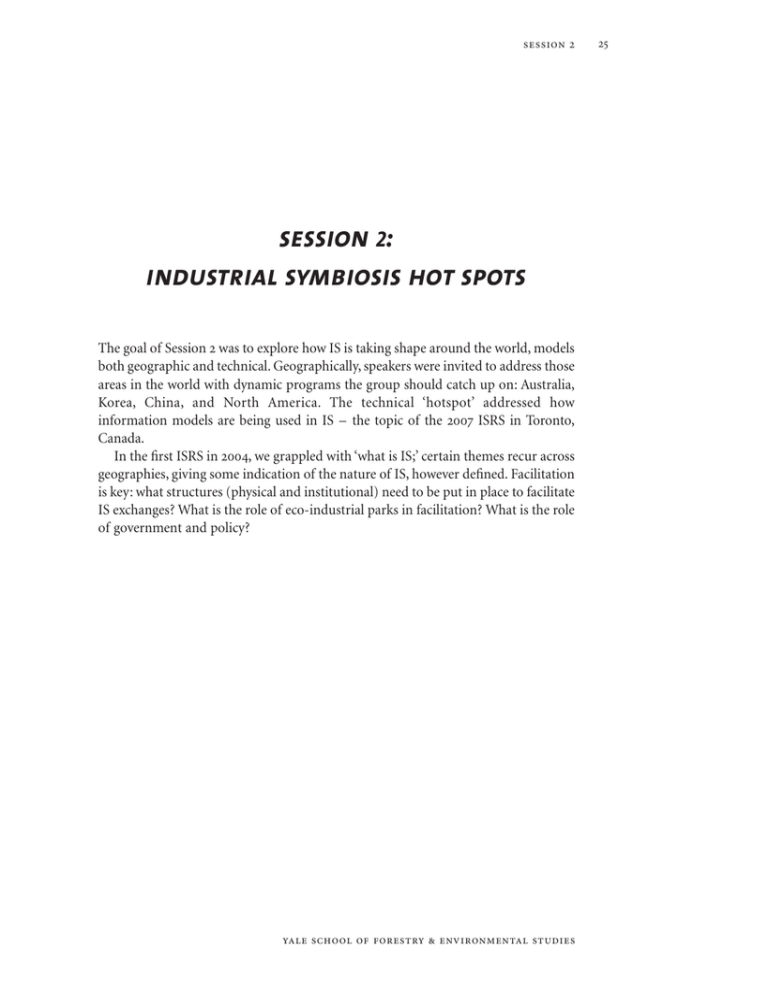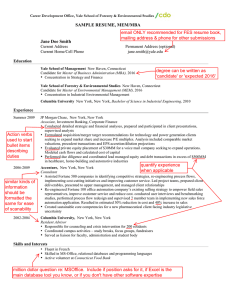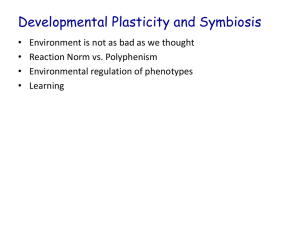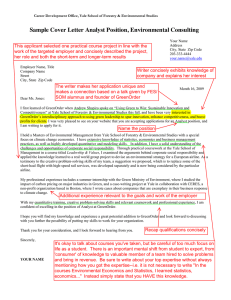session : industrial symbiosis hot spots 2
advertisement

session 2 session 2: industrial symbiosis hot spots The goal of Session 2 was to explore how IS is taking shape around the world, models both geographic and technical. Geographically, speakers were invited to address those areas in the world with dynamic programs the group should catch up on: Australia, Korea, China, and North America. The technical ‘hotspot’ addressed how information models are being used in IS – the topic of the 2007 ISRS in Toronto, Canada. In the first ISRS in 2004, we grappled with ‘what is IS;’ certain themes recur across geographies, giving some indication of the nature of IS, however defined. Facilitation is key: what structures (physical and institutional) need to be put in place to facilitate IS exchanges? What is the role of eco-industrial parks in facilitation? What is the role of government and policy? yale school of forestry & environmental studies 25 harris Industrial Symbiosis Activity in Australia Dr. Steve Harris, Centre of Excellence in Cleaner Production, Curtin University of Technology, Australia In the first presentation on IS activity in Australia, Dr. Harris discussed the value of the facilitated approach, and movement towards the creation of customised methodologies and tools for IS development. He also identified the need for consistent and transparent methodology for tracking benefits. The main industrial symbiosis (IS) activities in Australia occur in the heavy industrial areas of Kwinana (Western Australia, overseen by Curtin University of Technology) and Gladstone (Queensland, overseen by University of Queensland). There are two funded, interlinked research programmes that are supporting the development of further IS exchanges: the first, funded by the Australian Research Council, examines ways to foster the greater uptake of IS through facilitating structures that encourage information sharing and collaboration, guidance for companies on reaching contractual agreements, and evaluation methods to assess the triple bottom line benefits of IS; the second, funded by the Centre for Sustainable Resource Processing (www.csrp.com.au), provides practical support to industries to identify and develop IS at Kwinana and Gladstone, and includes a foundation project to create customised methodologies and tools for IS development. Promising developments have recently occurred that could see IS projects developing in Geelong (Victoria, Australia), Wagga Wagga (NSW, Australia) and Rustenburg (South Africa). In the Kwinana area, with 48 existing exchanges, the research identified over 90 potential IS exchanges [van Beers et al 2005; see Figure 2]. A screening method was developed that helped select the most promising exchanges to initially target. Current efforts focus on the development of 9 short-listed opportunities: ammonium sulphate, sodium sulphate, electrodes, grain, zirconium waste, treated effluent, oily wastewater, dust suppression water, and demineralised water. Similarly, work in the Gladstone region (currently 7 existing exchanges) is focussing on the following key areas: utilising consolidated waste as alternative fuel, water re-use and monitoring technology developments for large waste streams. yale school of forestry & environmental studies 27 28 industrial symbiosis in action Figure 1 The main industrial symbiosis activities in Australia Engineering and Technology Enabling Mechanisms Review and Promote Best Practice Geelong? Rustenburg (TBC) Assess Resource Assess and Improve Facilitating Structures Gladstone Inputs and Outputs Assess Resource Develop and Pilot Test Regional EcoEfficiency Opportunity Assessment Methodology Inputs and Outputs Kwinana Assess Resource Develop and Inputs and Outputs Screen Synergy Develop and Assess Resource Opportunities Synergy Inputs andScreen Outputs Design and Implement Operational Arrangements Opportunities Develop and Develop and Screen Synergy Opportunities Develop and Develop and Business Plans Screen Synergy Implement Opportunities Business Plans Implement Conduct Technology Assessments for Synergy Technologies Develop and Implement Develop and Apply TBL Evaluation Tools Business Plans Develop and Implement Business Plans Synergy project design Synergy process development Case Studies Supported by the Cooperative Research Centre for Sustainable Resource Processing (CSRP) Supported by the Australian Research Council (ARC) Source: van Berkel 2006 Figure 2 Existing By-product Synergies in Kwinana METHYL DIETHYL AMINE CARBON DIOXIDE AIR LIQUIDE OXYGEN NITROGEN ARGON CARBON DIOXIDE CARBON DIOXIDE ALCOA ALUMINA REFINERY ALUMINA AUSTRALIAN FUSED MATERIALS BAYER CROP SCIENCES BHP STEEL LOGISTICS BOC GASES FUSED ALUMINA FUSED ZIRCON AGRICULTURAL CHEMICALS TRANSPORT & FREIGHT LOGISTICS OXYGEN NITROGEN HYDROGEN HYDROGEN BP REFINERY OIL PRODUCTS SULPHUR CARBON DIOXIDE SPENT NITRATE CATALYSTS SPENT RCU CATALYSTS BRAMBLES WA MOBILE CRANES HIRE CBI CONSTRUCT. CHEMEQ DRUGS FOR DISEASE CONTROL IN COMMERCIAL ANIMAL PRODUCTION FABRICATION & EQUIPMENT WAREHOUSE CIBA SPECIALTY CHEMICALS COOGEE CHEMICALS COCKBURN CEMENT CEMENT & LIME FLOCCULANT LIME KILN DUST INORGANIC CHEMICALS TANK TERMINALLING CO-OPERATIVE BULK HANDLING GRAIN STORAGE SHIP LOADING 3-5% AMMONIUM CHLORIDE SOLUTION CSBP FERTILIZERS AMMONIA AMMONIUM NITRATE SODIUM CYANIDE CHLOR-ALKALI CHLORINE & CAUSTIC SODA DORAL SPECIALTY CHEMICALS CARBON DIOXIDE NUFARM AUSTRALIA AGRICULTURAL CHEMICALS KWINANA COGENERATION PLANT HIGH PURITY ZIRCONIA POWDERS ELECTRICITY FREMANTLE PORT AUTHORITY ELI ECOLOGIC SOIL DECONTAMINATION HISMELT CORPORATION SHIPPING & BULK PORT INSTALLATIONS PIG IRON GYPSUM NUFARM COOGEE CHLOR-ALKALI CHLORINE & CAUSTIC SODA NALCO AUSTRALIA WATER TREATMENT PROCESS CHEMICALS LIME KILN DUST ONE STEEL MARKET MILLS PATIO TUBING SHINAGAWA THERMAL CERAMICS REFRACTORIES SUMMIT FERTILISERS TERMINALS WEST FERTILISERS SUPPLIER & STORAGE OF PETROLEUM PRODUCTS TIWEST PIGMENT PLANT TITANIUM DIOXIDE 80% sulphuric acid 98% SULPHURIC ACID TYCO WATER STEEL PIPES UNITED FARMERS FERTILISERS UNITED KG FACILITIES MANAGEMENT ENGINEERING & CONSTRUCTION WATER CORPORATION WATER SUPPLY & TREATMENT WESFARMERS KLEENHEAT GAS WESFARMERS LPG PROPANE BUTANE LPG ELECTRICITY AMMONIUM SULPHATE COCKBURN POWER STATION ELECTRICITY KWINANA POWER STATION ELECTRICITY KWINANA NICKEL REFINERY NICKEL Source: van Beers et al. 2005 yale school of forestry & environmental studies VERVE ENERGY COGENERATION PLANT HYDROGEN SULPHUR HYDROGEN (BACK-UP SUPPLY) CARBON DIOXIDE harris Recently a review of 22 of the world’s most notable IS networks [van Berkel 2006] reported 162 exemplary exchanges. The review suggested that three ‘success factors’ necessary for IS projects to be realised were: Convincing business case: an opportunity to reduce costs, generate new revenue and/or secure access to vital resources that can be materialised by one or more businesses; and Societal license to operate: at the minimum all government approvals should be in place, but preferably also endorsement from affected communities, key non-governmental organisations and/or an opportunity to create or improve skills, jobs and/or livelihoods; and Proven technology: process and equipment are available to make the resource synergy happen, so that the resource is being transferred between the companies involved and converted as and when required. In the Kwinana area, current barriers to further synergies are community opposition and regulatory issues. This has resulted in recent plans to develop a communication strategy (that will help promote the positive aspect of synergies to the community, government, and other stakeholders) and a regulatory issues paper (to educate the regulators on the positive aspects of synergies and how current regulations and policy are stopping synergies that would have positive sustainability consequences). references van Beers, D., R. van Berkel and A. Bossilkov. 2005. Capturing Regional Synergies in the Kwinana Industrial Area: 2005 status report. Perth (WA), Australia, Centre for Sustainable Resource Processing. Available online at: http://www.csrp.com.au/ _media/pdf/3B1StatusReportAugust2005Final.pdf van Berkel, R. 2006. Regional Resource Synergies for Sustainable Development in Heavy Industrial Areas: an overview of opportunities and experiences. Perth (WA), Australia, Curtin University of Technology. Available online at: http://www.c4cs. curtin.edu.au/resources/publications/2006/arc_synergybaselinereport_may06.pdf yale school of forestry & environmental studies 29 kim Industrial Symbiosis Activity in Korea Professor Changwon Kim, Pusan National University, South Korea In the second presentation of the session, Professor Kim described the top down central government approach to IS in Korea. The presentation raised questions around scale (large numbers of small companies as opposed to fewer numbers of very large companies), and describes the role of dedicated EIP centres to facilitate exchanges. After a brief introduction to the economy of Korea, Professor Kim described the National Plan for Eco-Industrial Park (EIP) development, run by the Korean National Cleaner Production Centre and the Ministry of Commerce, Industries and Resources. There are 28 national Industrial Parks (IP) and 180 local IPs now. A threephase national effort to develop EIPs was launched in 2005 with the following objectives: the first 5-year phase (2005-2009) is to evolve 5 demonstration pilot projects; the 2nd phase (2010-2014), to extend the learning from the pilots to 20 IPs; and the 3rd phase to develop their ‘own style’ of EIP with the objectives of maximizing reuse within each park and achieving zero emissions. Additional objectives of the project include achieving harmony with the community, and sustainability. It is a top-down approach run by central government: the Ministry of Commerce, Industries and Resources has established an EIP centre in each park to organize companies and local authorities to facilitate exchanges, and as a resource for investigators and practitioners (see Figure 1). In 2006, three feasibility studies were started, including Busan, Incheon, and Daejeon. In Busan, the 2nd largest city in Korea, there are currently 2 IPs: one national, and one local government funded with a large number of very small companies (averaging 20 employees each). The two IPs are to be joined by a bridge so they are treated as one for the analysis, for a total of 2000 small companies, 10 large companies, and 8 industrial associations (employing over 46,000) that facilitate finding IS exchanges. Waste and by-product information is summarised from the city government: some waste streams (such as metal) are already captured and others not at all (sludge). Professor Kim proposes to establish a centre in the IP to analyse energy, by-product, and water flow networks through a process diagram & management technique, with the goal of making the IP an EIP, and eventually extending to Busan city. The vision was given of a sustainable Busan Eco-city (c 20162020) with a circular economy. yale school of forestry & environmental studies 31 32 industrial symbiosis in action Figure 1 Organizations participating in EIP centre In the Busan region, Professor Kim identified 15 existing networks amongst 30 companies. An example of existing IS networks in Korea is a steel company reusing wastewater on site, and using scrap to make steel bar; the slag currently goes to road pavement, but the dust is disposed of in landfill. Proposed exchanges include using the dust for brick additives manufacturer; using the treated wastewater for cooling; and capturing waste heat (see Figure 2). Professor Kim also demonstrated the potential for growth of industrial symbiotic networks in both the dyeing and leather industries. Figure 2 Industrial Symbiosis case study of a steel company, Korea. Current networks are in solid lines; potential exchanges are in dashed lines. Current IS Networks Potential Networking Cooling water Brick additive manufacturer Treated water (for cooling water) WWTP Wasted heat Electricity Landfill Cooling water Dust Water reuse Scrap merchant LNG Electricity Steel Making Process (1600 ) Scrap Slag Sludge recycling co. Road pavement Steel company Billet Water reuse Rolling Meal Process (1100 ) Customer Scale Wasted heat Recycling co. Steel Bar Recycling co. yale school of forestry & environmental studies POSCO -steel (Large Enterprise) lei Industrial Symbiosis Activity in China Professor Shi Lei, SEPA Key Laboratory of Eco-Industry, Tsinghua University, China In this presentation on IS activity in China, Professor Shi Lei described an approach in which the central government is the driver of EIPs and IS to address resource depletion and environmental pollution. He raised a number of questions around planning for IS, both technical and institutional. Professor Shi Lei also raised the issue of targets and benchmarking, as did Mr. Laybourn in Session 1. In response to rapid economic development, especially of the heavy industrial sectors, China looks to industrial symbiosis to deal with the increasing pressures of resource depletion and environmental pollution. As of September 2006, the Chinese Environmental Protection Agency (SEPA), the first central government agency to promote a circular economy, has established 16 national pilot eco-industrial parks (EIPs), the first in 2001 (see Table 2). Among them, 9 are based on resource-intensive industrial parks, 9 are based on existing Economic & Technical Development Areas (ETDA) or high-tech industrial parks, and one is a recycling-oriented park (see table 2). The National Development & Reform Commission (NDRC), the current leading agency to promote the circular economy, also approved 13 national pilot EIPs (4 ETDAs has been included in the list of SEPA), including 2 agricultural EIPs and Caofeidian industrial park where the Capital Steel company will be moved to due to the Olympic Games in Beijing. Besides the approved pilot EIPs, it has been announced that many other nationallevel and provincial-level industrial parks are to be built into EIPs, not to mention the industrial concentration sites at municipal and township levels (after December 2004, only national- and provincial-level industrial parks can be approved and named “industrial parks”; the total number is about 2700 currently). Documents have been issued to guide the planning and construction of EIPs, including the Technical Standards for the 3 types of EIPs by SEPA, which take into effect on September 1, 2006. Furthermore, the Circular Economy Law is in preparation with the support of the World Bank. However, EIPs are not the whole of industrial symbiosis in China. Industrial clusters are very popular in China, especially in the East China provinces of Zhejiang and Jiangsu. In fact, many products marked “Made in China”, such as shoes, ties, pens and toys, are produced from these clusters. Unlike the pilot EIPs mainly based on the yale school of forestry & environmental studies 33 34 industrial symbiosis in action heavy industrial sectors or foreign-invested sectors, these clusters usually focus on textiles and accoutrement, food manufacturing, metal hardware, and other lighter industrial sectors. Generally speaking, these clusters show remarkable differences from pilot EIPs in terms of resource efficiency, environmental performance and economic competitiveness. Together with the dynamic feature of China’s economy, the differences in components, placement, organizational structure and even origins existing in the two main industrial symbiotes make it difficult to understand industrial symbiosis in China. For example, what is the relationship between physical linkages and nonphysical linkages in industrial symbiotes? Another example, how does industrial symbiosis create or eliminate the path-dependency and lock-in phenomena? More practical questions, how does one integrate industrial symbiosis into the development of industrial parks? In simple words, not only natural resources, labour, capital investment and other non-institutional issues should be examined and reviewed carefully, but also policy, political structure and other institutional issues should be included. That is to say, understanding the institutional perspective, and not just the technological, is central to China’s industrial symbiosis. Some specific questions for planning a specific EIP only from technological perspective are: 1. Targeting. What are the targets for energy and/or resources usages, or what are goals for waste minimization of EIPs? Pinch analysis technique, a thermodynamics-based tool for analyzing production processes, may contribute to this question. 2. Topological structure. What topological structures are required to achieve these targets? Centralization or distribution, this question is central to almost every infrastructure planning problem. 3. Multi-objectivity and uncertainty. There are several goals to be traded off, and many uncertainties during the development process. 4. Ownership diversity. There are many enterprises in EIPs. How does one seek a balance among them? 5. Co-evolution. How does one deal with the co-evolutionary problems existing between land usages, infrastructure construction, and industrial development? acknowledgments I would like to thank Marian Chertow for her kind invitation and discussion; I also thank Anthony Chiu SF, Edgar Hertwich, and Han Shi for meaningful discussions. yale school of forestry & environmental studies lei Table 1 The national pilot EIPs approved by SEPA and NDRC (as of September 2006). No. 1 2 3 4 5 6 7 8 9 10 11 12 13 14 15 16 17 18 19 20 21 22 23 24 25 Name Guigang, Guangxi Nanhai, Guangdong Baotou, Inner Mongolia Changsha, Hunan Lubei, Shandong TEDA, Tianjin Fushun, Liaoning Dalian, Liaoning Suzhou High-tech park, Jiangsu Suzhou Industrial Park, Jiangsu Yantai, Shandong Guiyang, Guizhou Weifang, Shandong Zhengzhou, Henan Baotou, Inner Mongolia Antai, Shanxi Mengxi High-tech park, Inner Mongolia Wuhan, Hubei Yangling, Shaanxi Mudanjiang, Heilongjiang Luzhou, Sichuan Shanghai Chemical Zone Zhangjiagang, Jiangsu Caofeidian, Hebei Chaidamu, Qinghai Main sectors Cane-Sugar making Environment protection industry Aluminium Economic & Tech Develop. Park Chemicals Economic & Tech Develop. Park Minerals Economic & Tech Develop. Park High-tech park Industrial park Economic & Tech Develop. Park Coal & Phosphorous Chemicals Chemicals Aluminium Iron & steel Economic & Tech Develop. Park Agency SEPA SEPA SEPA SEPA SEPA SEPA/NDRC SEPA SEPA/NDRC SEPA/NDRC SEPA SEPA/NDRC SEPA SEPA SEPA SEPA SEPA High-tech park Agriculture Agriculture Coals Coal, NG Chemicals Metallurgy Iron & Steel Salt lake (K/Mg/B) NDRC NDRC NDRC NDRC NDRC NDRC NDRC NDRC NDRC yale school of forestry & environmental studies 35 chertow Industrial Symbiosis Activity in North America Professor Marian Chertow, Yale University, USA In this report, Professor Chertow highlights the policy issues and advances in North America at four levels: national, state/provincial, regional/local, and corporate/ NGO. national level Neither the U.S. nor Canada has a great deal of systematic IS activity at the national level. The U.S. Congress saw the reintroduction of HR 1237 “The Brownfield Redevelopment Assistance Act” in which eco-industrial development was highlighted as a preferred reuse for Brownfield sites. state and provincial level In 1996, Nova Scotia, Canada, adopted its “Solid Waste as Resources” policy, which encouraged closed loops on paper and cardboard to create a fibre cycle and to create a manufacturing fund. The law is attributed with the creation of over 1000 jobs. In 2006, seeking to align the large number of provincial development strategies in a common direction, Nova Scotia produced a strategy called “Sustainable Prosperity” as a cradle-to-cradle proposal embracing circular economy thinking that is both ecologically positive and business friendly. In the U.S., there was some state interest in water reclamation projects, particularly in Florida and California. regional and local level The former U.S. army base in Devens, Massachusetts, which has been a site for ecoindustrial development for many years, is actually becoming a separate town. Officials are updating the Master (Reuse) Plan with Goal 9 being to “support the efficient use of resources;” a regional approach to utilities is being studied. Three Canadian projects have made progress. Alberta’s Industrial Heartland, a global petrochemical and chemical cluster, is using eco-industrial development as a key strategic element. The Greater Sudbury Development Corporation in Ontario yale school of forestry & environmental studies 37 38 industrial symbiosis in action announced plans in July 2006 to create a web-based GIS 'synergy-finder’ tool for local businesses to build relationships and increase efficiencies across companies. The industrial park in Hinton, Alberta, received Canada’s first eco-industrial zoning designation with flexible development guidelines as well as a combination of $5 million in government grants and loans. This regulation is important from a practical standpoint for determining, for example, the legality of IS exchanges such as redistributing water. corporate/ngo Canada’s J.D. Irving Company is developing a project in the former Saint John Shipyard in New Brunswick to redevelop the area incorporating symbiosis opportunities into a ‘green’ industrial park. The U.S. Business Council for Sustainable Development is pursuing a ‘facilitated collaboration’ model to identify by-product synergies in Kansas City and Chicago USA. acknowledgments Thanks to many members of the Eco-Industrial Development Council for their updates. yale school of forestry & environmental studies grant Information Technology for Industrial Symbiosis Mr. Gabriel Grant, Purdue University, USA Mr. Grant reviewed the development of IT tools for IS over the past 10 years exploring how best to utilize IT to enable the growth of IS networks. Computers and computer models are good at storing vast amounts of information, and optimizing complex networks; they can also enable social networking. They cannot on their own identify the specific information needed, build the complex model, or leverage the social networks. The challenge thus is how to harness the power of the computer to advance IS. Starting in 1996, the US-EPA together with Industrial Economics Incorporated and Clark University developed an IS tool with 3 parts: a large materials and energy flows database (FaST); a linear optimization model to identify companies based on FaST output (DIET); and the REaLiTY tool that identifies potential regulatory, economic and logistical conflicts in the proposed linkages. Used in combination, the tools identified potential synergies between existing and potential firms, and checked the synergies against the database of potential barriers. The tool was applied a few times, but was deemed too complex for the general user. [Dubester 2000] A project started in 1997 by Bechtel to develop a set of tools yielded the Industrial Materials Exchange tool targeted for use by regional planners and industrial participants; two adaptations followed, the Dynamic IME (DIME) and Matchmaker tools. First put together for the Brownsville Economic Development Council, its function was similar to the FaST model. Keyword searches yielded false positives and false negatives; to address this, a group of Yale students developed a taxonomy which would enable multiple users to engage with the tool [Brown et al 2002; Burnham et al. 2001]. The Industrial Ecology Planning Tool (IEPT), developed by Carolyn Noble as a master’s thesis, was the first tool to integrate GIS capability, specifically focusing on water in the Baytown Industrial Complex. The GIS model allows the calculation of costs for transport based on real location data [Nobel 1998]. WasteX was developed by a group of companies in Jamaica to identify partners for waste exchange. The tool, focused on outputs only, was operationally online from yale school of forestry & environmental studies 39 40 industrial symbiosis in action 2001 to 2005. One barrier common to waste exchanges is the non-standard classification of wastes limiting usability [Clayton et al 2002]. Finally, Enabling Innovation (EI) is a project started in 2005 by a consortium of academic institutions and development agencies with the goal of enabling the exchange of knowledge and technology between developing communities. Target users include villagers, developmental organizations, and engineering students and instructors. Figure 1 Timeline of IT model development Our sweet mission statement here …. FaST DIET Opportunity REaLiTy ITIS Case Studies ?? IME MatchMaker! Lessons Learned Topics for Discussion EI DIME IEPT 1990 1995 WasteX 2000 2005 Challenges common to IT tools for IS over the time period examined: Usability: if the tool is designed for multiple users, a system must be in place to deal with various classifications for the same material Training and expertise required: goes to usability high start-up costs: who pays for the establishment and maintenance of such systems? More broadly, the issues raised by these IT tools are: What are the root barriers to IS and how might IT address these? It might not be a complex optimization model, it might be social capital – in which case how can IT tools help? What is the minimum information required to make useful suggestions for by-product synergies? How do we lower the cost of entry? yale school of forestry & environmental studies grant references Burnham, C., A. Mangan and D. Groberg. 2001. By-Product Synergy: A Tool for Sustainable Greenhouse Gas Emissions. http://web.archive.org/web/20020816083110/ www.bcsdgm.org/bps_abstract.htm#reference%22 Brown, J. Gross D, and L Wiggs. 2002. The MatchMaker! System: Creating Virtual EcoIndustrial Parks. Yale F&ES Bulletin Number 106, pp. 103-136. Clayton, A., Muirhead, J., and H. Reichgelt. 2002. Enabling Industrial Symbiosis through a Web-based Waste Exchange. Greener Management International 40: 93-106. Dubester, L. 2000. Materials Flow Through the Community: Creating New Resource Opportunities. August 2000 http://www.chelseacenter.org/pdfs/rbed_cet.pdf Nobel, C. 1998. A Model for Industrial Water Reuse: A GIS Approach to Industrial Ecology. Bureau of Engineering Research. Austin, University of Texas. M.S. in Engineering: 142. yale school of forestry & environmental studies 41 session 2 – discussion and research questions Session 2 – Discussion and Research Questions Certain themes recur across geographies, regardless of whether it’s a topdown government driven approach, or a voluntary, Nordic/NISP model approach. Do they substantiate those universal success factors to IS that have been identified in the literature? How do such universal factors inform the debate over ‘what is IS’? What are the barriers and enablers to IS within existing regulatory and legislative frameworks? What characterizes the optimal IS policy framework (legality of exchange; societal license to operate; planning process)? Facilitation of the social networks has been identified as critical to IS; is there a role for legislation or regulation regarding these social networks – for example, requiring government capital tenders to consult with existing local IS or business networks? Much has been said about the regulator role in IS, often in connection with barriers. How do we move from informing and educating the regulators about IS to proactive involvement and partnership over time? What, if any, inconsistencies with their remit might exist? How much can we rely on IT models to facilitate IS? IT models may be able to identify a number of potential IS exchanges, but their identification does not always lead to their implementation. Perhaps models can be programmed to deal with poor quality data, but if the network and social capital are central, a theme that recurs throughout the symposium, is this an inherent limit to their usefulness? Does this not suggest that further model development should be done in conjunction with engagement models to inform the development of the IT tools? In each IS system, it must be determined who collects data, who maintains it, and who owns it. Focusing on collection, three choices have been identified: government mandated surrender of data; facilitators collecting data directly from companies; and companies entering data into a common database themselves. Quality of data is a critical issue, as identified in the modelling work in the 1990s and again recently by NISP. In the past, yale school of forestry & environmental studies 43 44 industrial symbiosis in action distributed input of data led to poor quality information; various companies were entering materials flows using trade names, resulting in taxonomy issues. One difference between compulsory and voluntary provision of data may be that the voluntary set is incomplete – you get what the companies want to give you. In the NISP experience, that is still enough to identify synergies, and over time, as trust develops, companies are more forthcoming with information. What is the most efficient way to handle data collection, and how does it depend on context? The cost of entry for companies has been discussed as a barrier to IS, raising the question of who pays? Should support derive from the public sector (as with the UK-based NISP model) or are there ways for the networks to be supported by industry (as with the US-based By-Product Synergy model)? What are the implications for each model? How will the results differ? To what extent has IS been explored as a source of innovation? Under what conditions can IS act as an accelerator to research and development? The common assumption that proven technologies are required for IS is contrary to unpublished work by the University of Birmingham which found that of 125 synergies completed under the auspices of NISP, 19% involved new technological development or pure research. IS drives innovation in a certain direction – can we do it more intentionally, for example, through research programs to develop new products and processes to use certain flows? Water shortage as a constraint needs a local solution, as does finding a user for low grade waste heat. From an engineering perspective one asks, are these generic problems with generic solutions? yale school of forestry & environmental studies




